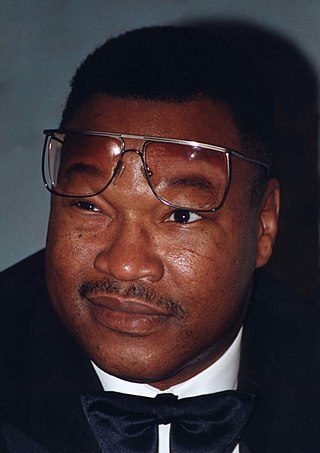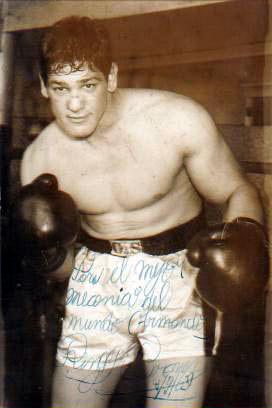
Larry Holmes is an American former professional boxer who competed from 1973 to 2002 and was world heavyweight champion from 1978 until 1985. He is often considered to be one of the greatest heavyweight boxers of all time. He grew up in Easton, Pennsylvania, which led to his boxing nickname of the "Easton Assassin".

George Edward Foreman is an American former professional boxer, entrepreneur, minister, and author. In boxing, he competed between 1967 and 1997 and was nicknamed "Big George". He is a two-time world heavyweight champion and an Olympic gold medalist. As an entrepreneur, he is known for the George Foreman Grill.

Joseph William Frazier, nicknamed "Smokin' Joe", was an American professional boxer who competed from 1965 to 1981. Widely regarded as one of the greatest heavyweight boxers of all time, he was known for his strength, durability, formidable left hand, and relentless pressure fighting style and was the first boxer to defeat Muhammad Ali. Frazier won a gold medal at the 1964 Summer Olympics as an amateur, held the NYSAC heavyweight title from 1968 to 1973, and was the undisputed heavyweight champion from 1970 to 1973.

Kenneth Howard Norton Sr. was an American professional boxer who competed from 1967 to 1981. He is considered by some to be one of the greatest heavyweight boxers of all time. He was awarded the WBC world heavyweight championship in 1978, after winning a close split decision over Jimmy Young in a title eliminator bout, after which Leon Spinks refused to fight with him.
Jimmy Young was an American heavyweight professional boxer. Young was known for his awkward, defensive style and counterpunching. He was one of the top contenders of the 1970s, most notably earning a victory over George Foreman in 1977 and losing a unanimous decision against Muhammad Ali in 1976. Young fought many significant fighters of his era, including twice outpointing Ron Lyle and losing only by a split decision to then-number one contender Ken Norton in a title eliminator in late 1977. A fellow boxer, Bobby Watts, was his cousin.

Joe Frazier vs. Muhammad Ali, billed as The Fight of the Century or simply The Fight, was an undisputed heavyweight championship boxing match between WBA, WBC, and The Ring heavyweight champion Joe Frazier and Lineal champion Muhammad Ali, on Monday, March 8, 1971, at Madison Square Garden in New York City.

Earnie Dee Shaver, best known as Earnie Shavers, was an American professional boxer who competed between 1969 and 1995. A two-time world heavyweight championship challenger, he is known as one of the hardest punchers in heavyweight boxing history. He scored 70 knockout wins, including 23 in the first round, for a 76.7% overall knockout rate.

Ronald David Lyle was an American professional boxer who competed from 1971 to 1980, and in 1995. He challenged unsuccessfully for the world heavyweight championship, losing to Muhammad Ali in 1975. Known for his punching power, crowd-pleasing fighting style, and his courage and determination in the ring, Lyle defeated Buster Mathis, Oscar Bonavena, Jimmy Ellis, Vicente Rondón, Earnie Shavers, Joe Bugner, Gregorio Peralta and Scott LeDoux, but is best known for his fight against George Foreman in 1976, which was voted Fight of the Year by The Ring magazine.
Jerry Quarry, nicknamed "Irish" or "The Bellflower Bomber", was an American professional boxer. During the peak of his career from 1968 to 1971, Quarry was rated by The Ring magazine as the most popular fighter in the sport. His most famous bouts were against Muhammad Ali. He is often seen as being one of the Best Heavyweight Boxers never to be Champion. He beat Heavyweight Champion Floyd Patterson and top contenders Ron Lyle, Earnie Shavers, Brian London, Thad Spencer, Buster Mathis, Randy Neumann, Jack Bodell, Mac Foster and Eduardo Corletti. He accumulated damage from lack of attention to defense against larger men at the top level, no head guard sparring, and attempted comebacks in 1977, 1983 and 1992 resulted in Quarry developing an unusually severe case of dementia pugilistica.
During the 1970s, boxing was characterized by dominating champions and history-making rivalries. The decade had many superstars, who also had fierce rivals. Alexis Argüello, for example, who won the world Featherweight and Jr. Lightweight titles in the '70s, had to overcome Alfredo Escalera twice before the decade was over.

József Kreul Bugner is a Hungarian born British-Australian former professional boxer who competed in the heavyweight division and actor. He holds triple nationality, originally being a citizen of Hungary and a naturalised citizen of both Australia and the United Kingdom. He unsuccessfully challenged Muhammad Ali for the heavyweight championship in 1975, losing by a unanimous decision. As an actor, he is best known for his role in the 1994 action film Street Fighter alongside Jean-Claude Van Damme and Raul Julia.

Oscar Natalio "Ringo" Bonavena was an Argentine heavyweight professional boxer with a career record of 58 wins, 9 losses and 1 draw. A rugged, wild-swinging puncher, he was nicknamed "Ringo" because of his Beatles haircut, and enjoyed professional success in both Argentina and the United States. He is remembered for giving Joe Frazier and Muhammad Ali hard fought bouts.
Leotis Martin was an American boxer, the first ever NABF heavyweight champion. Martin is best known for his victory over former-undisputed heavyweight champion Sonny Liston. A good puncher and fairly skilled heavyweight, he compiled a record of 31 wins and 5 losses from 1962 to 1969. Outside of Liston, he also won against top contenders Alvin Lewis, Karl Mildenberger, Thad Spencer, Sonny Banks, and Roberto Davila, and was listed by The Ring as one of the 100 greatest punchers of all time. His career, however, was marked by inconsistency and bad luck.

James Albert Ellis was an American professional boxer. He won the vacant WBA heavyweight title in 1968 by defeating Jerry Quarry, making one successful title defense in the same year against Floyd Patterson, before losing to Joe Frazier in 1970.

Brian Sidney Harper, better known by the ring name Brian London, was an English professional boxer who competed from 1955 to 1970. He held the British and Commonwealth heavyweight title from 1958 to 1959, and twice challenged for the world heavyweight title, losing to Floyd Patterson in 1959 and Muhammad Ali in 1966, both times via knockout. He was one of a quartet of British boxers, with Henry Cooper, Joe Erskine, and Dick Richardson, who dominated the British boxing scene throughout the 1950s and 1960s.

Joe Frazier vs. George Foreman, billed as The Sunshine Showdown, was a professional boxing match in Kingston, Jamaica contested on January 22, 1973, for the WBA, WBC and The Ring heavyweight championships.

George Foreman vs. Joe Frazier II, billed as "Battle of the Gladiators", was a professional boxing match contested on June 15, 1976, for the NABF heavyweight championship.

Muhammad Ali fought three professional boxing matches against Ken Norton between 1973 and 1976. Ali won the series 2–1, though the final fight was highly controversial.
Muhammad Ali and Jerry Quarry fought two boxing matches with each other. The first bout took place on October 26, 1970, and the second on June 27, 1972. Ali won both fights through technical knockouts. The first match was Ali's first fight since his suspension from boxing in 1967, and the second was fought for the NABF title.

Muhammad Ali was a boxer who mastered the rope-a-dope fighting technique. He is widely regarded by many boxing commentators and historians as the greatest heavyweight boxer of all time. Boxing magazine The Ring named him number one in a 1998 ranking of greatest heavyweights from all eras. In 1999, The Associated Press voted Ali the number one heavyweight of the 20th century.














